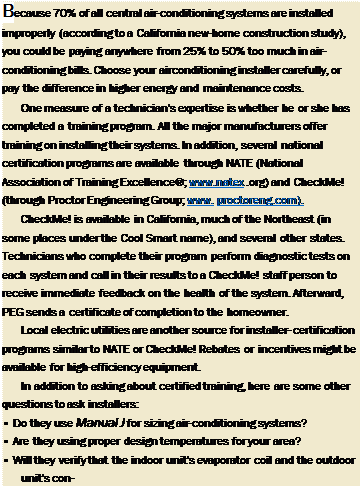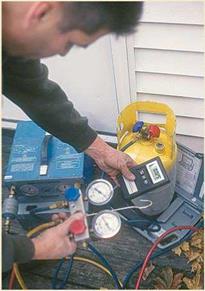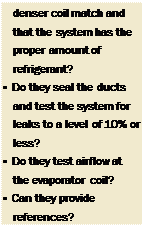Contractors Sell Large Systems because They Fear Complaints
In defense of the people selling and installing large air-conditioning systems, they do so for a reason. Profit plays a part, sure: If you install a bigger system, you make more money. More important, though, contractors fear complaints about their systems’ inability to maintain set temperatures in extremely hot conditions. Using a rule-of-
thumb measurement or some other method, the contractor sizes the system larger. If 3 tons is good, 4 is better, right? Besides, "Maybe Manual J sizing isn’t quite big enough," a contractor might say, or "Here, it gets hotter than that."
A recent study, however, puts these fears to rest. Proctor Engineering Group (PEG), Electric Power Research Institute, Nevada Power, and Arizona Public Service tested a typical house with outdoor temperatures of up to 116°F (3°F above the mean extreme). The actual cooling required was less than Manual J predicted in all but three of the 1,316 hours that the house was monitored.
It’s not necessary to oversize beyond Manual J, which has a built-in oversizing margin. On the first page of the introduction, Manual J states that "slightly undersized cooling equipment—by a margin of 10% or less—may actually provide more comfort at a lower cost."
Most Air-Conditioning Systems Are Installed Improperly
Another major reason for poorly performing air-conditioning systems is faulty installation: incorrect refrigerant levels, low airflow, and poorly designed and installed duct systems.
In one study of 55,000 air-conditioning systems by PEG, refrigerant levels were wrong 62% of the time; in another study, the figure was 68%.
Condenser units arrive from the factory with the proper amount of refrigerant for a given length of piping—usually 15 ft. or 25 ft.—to connect the indoor and outdoor units. Refrigerant levels often are wrong because line length in the field can vary, and technicians frequently don’t make adjustments according to the manufacturer’s recommendations.
What difference does it make if refrigerant levels are wrong? According to Armin Rudd of Building Science Corporation, if




they are a little low, up to 20%, there’s some loss of cooling. More than that, and there’s an unacceptable loss of cooling along with frosting of the evaporator coil and, eventually, complete loss of cooling. If refrigerant levels are too high, the story is similar: loss of cooling with possible damage to the compressor.
The speed and the volume of air moving through air-conditioning systems were incorrect (usually too low) in about 72% of units tested in the PEG study. This was due partly to mismatched indoor and outdoor units, which occurs more often on retrofits than on new installations because only the exterior compressor/condenser unit typically is replaced. Also, airflow at the evaporator coil often is low because it usually isn’t tested, so no one actually knows what it is.
Fan speeds at the evaporator coil should be around 400 cfm (cu. ft. per minute) per ton of cooling capacity. Slightly lower fan speeds improve dehumidification. In dry climates, fan speed should be increased.
Tied to airflow and directly affecting it are duct design and installation. Ducts are the least expensive part of the system and frequently are given short shrift. A properly designed duct system begins with determining the cooling load for each room (not based on the square footage), which can vary greatly. Duct runs need to be as short as possible; they need to be insulated; and when possible, they should be installed within conditioned space. Ducts also should be sealed. Leaky ducts waste energy and in the right conditions might draw dust, spores, or combustion gas from a gas appliance back into the house.
Adequate return air also is important to minimize air-pressure imbalances that can affect cooling. The placement of registers in the room and the quality of the grilles greatly affect the duct system’s ability to throw air across the room and to mix the air properly.
Chris Green is a carpenter and cabinetmaker in New Milford, Conn.






Leave a reply